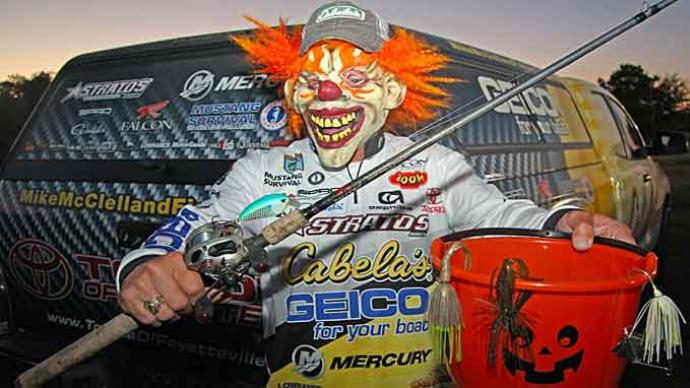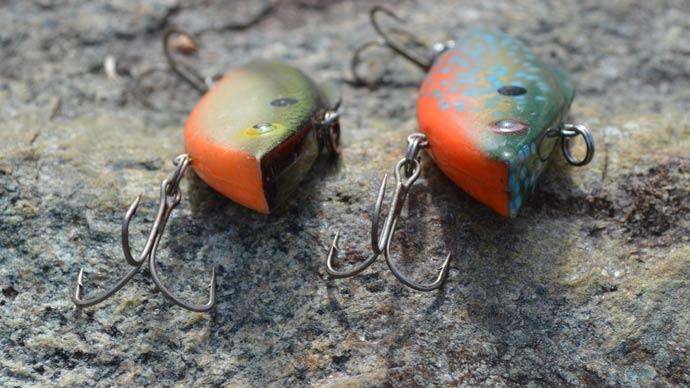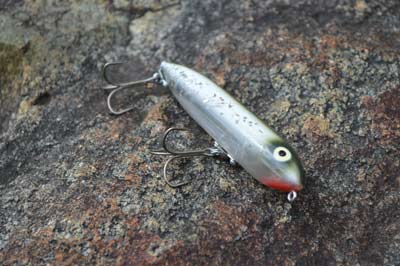
Fall brings some of the year’s best bass fishing. Temperatures are cool, making it more pleasant to be on the water and shutting down pleasure boat traffic. That, along with dwindling daylight, makes the bass bite better. Not to mention, they’re in relatively shallow water and easy to access.
Making the most of the fall bite starts with finding the best spots. Sealing the deal requires fishing the best baits. So, when you head to your favorite fishing spot in September, ensure you have these five lures rigged and ready. They'll treat you right now and, in many cases, next month, too.
Walking Topwater
- Examples: Zara Spook, Reaction Innovations Vixen, Berkley Drift Walker
- Size: 4 inches to 5 inches
- Colors: Shad, perch, or frog
While Labor Day may signal the end of wearing white, it’s not the end of fishing topwaters. These bass angler favorites continue to produce as the water temperature falls into the 50s. That's because there are still plenty of smallmouth, largemouth, and spotted bass chasing schools of baitfish in shallow water. And this classic topwater style does the best job of imitating them.
Use a fan-casting approach to cover water, whether the back of a dead-end pocket, shoal, point, or submerged bed of aquatic vegetation. Keep your walking topwater moving at a slow and steady pace. That cadence has the power to call bass from long distances — vertically and horizontally — in clear or slightly stained water.
Usually, color choice is more about your confidence than what bass are eating. Bass will track the lure’s action and strike at its profile. So, walking topwaters with a solid-color belly is best, especially on overcast days. Try a clear lure in extremely clear water when bass are striking your bait without getting hooked. Bass will detect its action but won’t see a profile. Eating it is the only way they can find out what it is.
- Rod: 6 1/2- to 7-foot baitcasting rod with medium-fast action and heavy power
- Reel: Low profile baitcasting reel with a high-speed retrieve — at least 7:1 gear ratio
- Line: 12- to 17-pound test monofilament
Modern bass anglers prefer long rods. But this is one lure that is better served with a short one. Downward movements are vital to making it walk the dog — the side-to-side action that bass can’t resist. Keeping a bit of slack in your line — use monofilament because it floats, unlike fluorocarbon — will increase your lure’s range of motion.
Jig and Trailer
- Examples: Lunker Lure Rattleback, Strike King Denny Brauer Premier Pro Model, Picasso Shooter Lures
- Size: 3/8 ounce or ½ ounce
- Colors: Black, black and blue, green pumpkin, or brown and orange
Jigs are the most versatile bass lure. They work regardless of the conditions or situation — deep or shallow, thin or thick cover, hot or cold water. And they excel during September.
Use them to probe for largemouth around shallow-water cover in natural lakes and large rivers. Focus on spots where two types of cover intersect, such as rock and aquatic vegetation. Flip your jig into that edge, and let it soak. Hop it a time or two, then pull it in and fire out the next pitch. You want to work your jig slowly but cover water. When you do get a bite, pitch back into the same spot. Fall bass are notorious for traveling in small schools.
You want to give bass a big meal, so make sure your jig is bulky. It should sport a full skirt and large trailer. The latter should have paddle-style kickers or be made from buoyant plastic. Both will create action as your jig sits on the bottom. And that little extra movement often is enough to trigger a strike from a bass that watched it sink to the bottom.
- Rod: 7- to 7 ½-foot baitcasting rod with heavy power and fast action
- Reel: Baitcasting reel with fast retrieve — 7:1 to 8:1 gear ratio
- Line: 15- to 20-pound test monofilament or fluorocarbon or 50- to 65-pound test braid
There’s been a resurgence in pork rind trailers, especially with the re-introduction of some classic Uncle Josh shapes. Old-timers swore by their effectiveness in cold water, though modern soft-plastic trailers remain flexible at even the lowest temperatures. But pork rinds can give you an advantage on pressured waters by showing bass something different.
Umbrella Rig
- Examples: Shane’s Baits, YUM Yumbrella, or Hog Farmer Baits
- Size: Three-arm or five-arm
- Colors: Shad, perch, or baitfish swimbaits
Image
While its popularity may have waned over the past decade, the umbrella rig remains a top lure for September bass. Use it to catch bass schooling on shad or baitfish. Photo by Pete M. Anderson Maybe it’s forward-facing sonar stealing the headlines. But the uproar over umbrella rigs seems to have subsided since they exploded on the scene in 2011 when tournament veteran Paul Ellias used one for a lights-out win on Alabama’s Lake Guntersville. But that doesn’t mean they’ve lost their effectiveness. They’re still strong producers, especially when baitfish school in the fall.
Umbrella rigs and their three or five swimbaits catch largemouth from Southern impoundments as well as smallmouth from Northern natural lakes. The key is focusing your fishing on stretches where baitfish are present. They’re too heavy and unwieldy to go searching for individual bites. So, concentrate your casts where baitfish and bass are most likely to be — windblown points and banks and neckdown areas such as bridges.
Lean toward smaller swimbaits in baitfish patterns. It doesn't hurt to include one that is brightly colored. This target may get a bit more often because it's different than the rest. And use lead heads specifically designed for these rigs. They usually are lightweight but sport a large hook.
- Rod: 7- to 8-foot baitcasting rod with a medium action and heavy power
- Reel: Wide spool 300 series or larger baitcasting reel with medium retrieve — 6:1 to 7:1 gear ratio
- Line: 50- to 65-pound test braid
Check local fishing regulations before you start heaving an umbrella rig. Some states and provinces, and in some cases particular bodies of water, restrict the number of hook points that can be used simultaneously. If there isn’t a rule, then get after it. But if there is, you have options. Rigs with two or three arms are available. And you may be able to use “dummy baits” on a standard five-arm rig. These are the same soft-plastic swimbaits, but they’re rigged without a hook.
Grub
- Examples: Kalin’s Lunker Grub, Chompers Single Tail, Venom Super Swimmer
- Size: 4 inches to 5 inches
- Colors: Pumpkin or smoke in clear water, pearl or black in dirty water
Image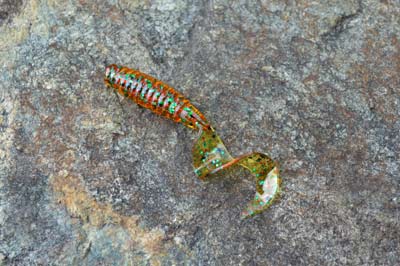
Grubs are a versatile soft-plastic lure that largemouth, smallmouth, and spotted bass eat without hesitation. Rig them on a lead-head jig or Texas style. Photo by Pete M. Anderson Grubs are a sleeper lure. Not many anglers fish them, and fewer are talking about them. But that's good for you. Rig one up, and you'll be showing bass something different, not to mention a perfect imitation of the baitfish they're eating.
Soft-plastic grubs come in various lengths and tail designs, but the one you want for September measures 4- to 5-inches long and has a large, thin, sickle-shaped tail. It creates plenty of action regardless of the direction it's moving. Color choices are simple. Natural patterns like pumpkin or smoke are best in clear water. If it's stained, you'll want pearl, black, or green pumpkin.
While historically seen as a lure for smallmouth, grubs also catch their fair share of largemouth. Where you fish them depends on how you rig them. Go after largemouth hanging around aquatic vegetation or wood by Texas rigging your grub with a 1/8- or 3/16-ounce bullet weight and 2/0 straight shank hook. Targeting smallmouth in deeper or open water? Rig your grub on a ball-head jig molded with a 2/0 or 3/0 hook and a 90-degree line tie.
- Rod: 7-foot spinning rod with medium power and fast action
- Reel: 2500 or 3000-size spinning reel with large diameter spool and front drag
- Line: 6- or 8-pound test fluorocarbon or braid
Regardless of whether you choose to put your grub on a jig head or Texas style, rig it so its tail curves in the opposite direction of the hook. That reduces fouling — the tail coming around and snagging the point.
Medium-Diving Crankbait
- Examples: Norman Deep Little N, Rapala DT6, Bomber Model 7A
- Size: 2 1/2 inches to 3 inches
- Colors: Shad, perch, chartreuse with blue back, or crawfish
Image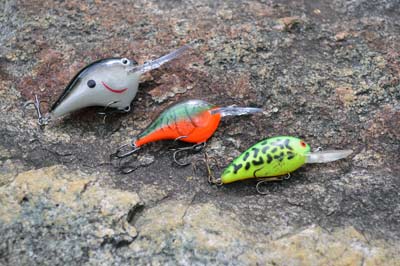
Crankbaits perfectly imitate baitfish, which bass key on in September. Medium-diving ones are perfect for cranking laydowns for largemouth or the edges of shallow shoals for smallmouth. Photo by Pete M. Anderson Bass are particular. That’s especially true in September when they begin feasting on small baitfish. Large lures often go ignored, while smaller ones get scarfed up by all bass sizes, including big ones. That's why having a medium-diving crankbait at the ready is essential.
These crankbaits, which dive 6- to 10-feet deep, are typically equal parts bill and body. Their relatively small bodies better match small baitfish. And they dive to the perfect depth, whether you’re cranking the inside edge of aquatic vegetation for largemouth or the top of a shallow shoal for smallmouth. They also produce in the slightly deeper and slower water along the outside of river bends.
Presenting these crankbaits requires the perfect balance of rod, reel, and line. That ensures accurate casts, plenty of lure action, and the ability to hook, play, and land even the feistiest bass. So, learn toward these:
- Rod: 7-foot baitcasting rod with a slow action and medium-heavy power
- Reel: Baitcasting reel with a medium retrieve speed — 6:1 to 7:1 gear ratio
- Line: 8- to 14-pound test monofilament or fluorocarbon
Don’t hesitate to up the pound test of your line and cast your crankbait near or into cover such as laydowns and along edges of aquatic vegetation beds. Its two dangling treble hooks can make it a daunting task. But it can be done if you plan where your cast will land and the route your crankbait will exit. Yes, you'll hang up occasionally. You may even lose a crankbait or two. But the additional bites that you generate will make it worth it.
BassResource may receive a portion of revenues if you make a purchase using a link above.


